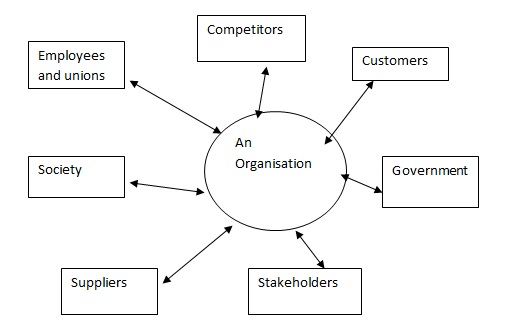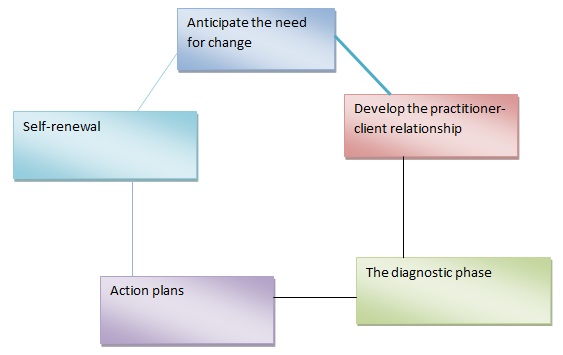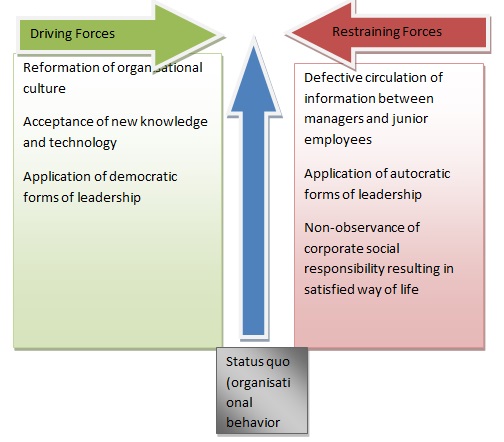Introduction
This article focuses on assessing the effectiveness of organisational development strategy with an aim of the performance of HTC Corporation given the fact the organisation is faced with the major challenge of sustaining production and meeting business goals. The paper aims at proposing the changes that should be undertaken in the firm to facilitate improvement as far as profitability is concerned (Brooks 2004). It is noted that employee motivation and job satisfaction are some of the factors to consider when enhancing the financial position of the organisation in the highly competitive market.
Brown was one of the management scholars who developed a five-stage model framework of dealing with the issue of organisational development. In his model, Brown emphasised on the need for change, improving the relationship between the practitioner and the client, diagnosing the problem carefully, drafting action plans, and focusing on self-renewal. These aspects would be reviewed in order to improve the performance of HTC Corporation in the global market. Since information on the company is not readily available, coming up with assumptions was critical after analysing the questionnaires and surveys.
Organisational Development Theory
As Brown (2014) observed, the field of organisational development was first discovered in 1930s when scholars applied knowledge from behavioural sciences and styles to understand the issues that affected goal attainment in the work place. Even though scholars are yet to come up with a comprehensive definition of organisational development, Brown was of the view that it entails all activities meant to improve an organisation’s survival in the highly competitive market. In his analysis, the practitioner should be focused on designing new strategies of problem solving and renewal of processes (Brown, 2011).
Beckhard contributed in the field of organisational development by noting the management should put an effort in order to augment effectiveness meaning any change process should start at the top and the best approach is behavioural whereby people aspirations and values are understood first. Unfortunately, Beckhard’s theory never withstood criticism because it contained several flaws, one of them being the claim that an organisation is likely to introduce change because of external pressures implying that there would be no time to plan for change.
Secondly, he went contrary to the popular believe that change should happen at the top behaviour tricking down to the junior managers and employees. Again, he came up with a radical conclusion that organisations were becoming less hierarchical and teams were taking over the positions that were previously held by the executive (Guilmartin 2010).
Brown observed that organisational development has various characteristics, each with a distinct focal area as shown in the following table:
Change is never a static aspect meaning that it is dynamic in the sense that an organisation should be concerned with reinventing the new ways of boosting its image and performance. Brown observed further that an organisation is faced with both internal and external challenges as shown in the figure below.

Understanding major aims and the purpose of organisational development calls on an individual to comprehend the context in which the company operates. Brown urged individuals to appreciate the fact that an organisation does not exist in isolation implying it will always interact and interrelate with other external and internal entities in a cycle (Brown 2010). Regarding global business, appreciation of the impacts of external forces is critical since it enables the management to draft sufficient policies that would give it an advantage locally and internationally. The chart below shows various interactions of a business unit with other units.
Brief Profile of HTC Corporation
The current trend in the organisation suggests that the company is headed for a landslide failure because the volumes of sales are ever decreasing while competitors are gaining. The company first rose to prominence in early 2000s when it managed to produce the first Smartphone, with analysts observing that it was smart enough to outdo its competitors in producing a mobile devise that was compatible with android adopter. The devise offered the best alternative to individuals in need of Google-centric phone, as it replaced iPhone (Wagstaff & Jim 2013).
With the coming of Samsung in the phone market, HTC Corporation was unable to withstand the heat forcing it to look for other explored markets. The introduction of Samsung Galaxy kicked HTC’s products from the high-end market (Zeman, 2013. Unfortunately, the management of the organisation did not have any strategy to ensure that it remains relevant in the new competitive market. Currently, the company is coming into realisation that it might be forced to close its operations in various high-end markets if it continues to compete with Apple and Samsung. Recently, it released a statement urging customers to be prepared to receive new affordable products in the market meaning the target is the low-end and middle-range markets.
The company would have managed to stay in the market for long and sustain profits in case it made a decision early to adopt this strategy because the low-end market is highly competitive implying that the strategy might not function as expected. Apart from facing competition from established companies offering goods and services in the low-end market, the organisation will have to deal with the reality that Microsoft is entering the already crowded market and its target is the low-end users (Ilinca 2009. The company is prepared to diversify production in order to survive in the highly competitive market, as it advertised recently that it intends to manufacture smart watches to supplement sales. However, the strategy is deemed to fail as well because the technology is already in the market (Cole 2004).
Brown’s Five Stages Framework

Anticipate the need for change (also known as establishing the performance gap in the organisation)
The findings of various analysts suggest that the market share of HTC Corporation is below one-percent meaning the company will soon be forced to close its operations if something is urgent is not done to avert the situation (Chao 2010). Other competitors, including Apple and Samsung, are taking over the markets that belonged to HTC Corporation. The market share of the organisation fell drastically because of the underperformance of some brands in the market. Some products failed to hit the market and the company registered poor sales leading to losses.
The company was associated with quality products globally, but its shift in strategy to focus on middle-range markets caused products as far as quality was concerned leading to the loss of some valued clients. Currently, the organisation is in the process of firing several employees in an attempt to cut down on expenses given the fact the revenues cannot sustain the expenditures. In recent years, it has fired over fifty percent of staff and some are to follow their colleagues in other organisations. Because of a defective leadership style introduced by the current CEO and poor strategy, many workers decided to quit their positions to join other companies offering similar products and services (George 2011).
Members of the organisation suffer from low morale, which acts as a de-motivating factor leading to turnover. In the world of corporate governance, the organisation is doing nothing to deem its image since it was accused variously for being indifferent to the demands of the environment. Additionally, the management is reluctant to incorporate the best technologies, styles, techniques, and methods that would match those of competitors. Through this analysis, it is noted that HTC Corporation is faced with several challenges and its downfall is eminent in case something is not done urgently (Culpan & Miller 2011).
Many organisations have presented their bids to either merge or acquire the company, but the management has failed to strike a deal on several occasions. Even though the organisation is engaged in constant research and consultation to formulate the best strategy, something has to be done to bring it back to its initial status. One of the problems facing the corporation of defective leadership since the current CEO does not appreciate the efforts of other workers. It is clear from the analysis that the company has some weaknesses that makes it struggle for survival (Yu-Huay & Lococo 2013).
Develop the practitioner-client relationship
In this stage, it is concluded that introduction of change at HTC Corporation is a matter of issue meaning it is inevitable in case the organisation is to survive for a few years (Culpan & Miller 2011). For instance, the gap in performance should be bridged and this would be done better through the change of organisational culture based on the ideas of Lewin Forcefield. In any organisation, drivers of change will always exist, as well as the restraining factors. Therefore, the first step towards improving the performance of the organisation would be analysing the drivers and the constraints. Change should aim at establishing balance, what scholars referred to as quasi-stationary equilibrium.

Theory of Planned Change
According to Forcefield, various drivers and inhibitors of change exist in an organisation. While some forces might be in support of change, others would be opposed. In HTC Corporation as well, some individuals are viewed as drivers of change while others are major impediments. The stage is focused on categorising drivers and pinpointing inhibitors. In his theory of planned change, Forcefield observed that members of the organisation must first agree that a problem exists and introduction of change is mandatory. Based on this, an individual would then reflect on his or her behaviour regarding the existing problem with an attempt to provide a solution. However, the process is continuous since calls for evaluation and monitoring.
Diagnostic Phase
Brown noted that Organisations face various challenges in the modern society and flexibility is advisable in case any of them wants to initiate reforms. For instance, an individual intending to bring change has to identify the issue, as well as suggest the ways on how to improve the performance. Several techniques are proposed meaning that the practitioner has various options, including the use of questionnaires to collect information, analysing the performance gap, use of socio-metric data, and observing the problem directly in the field.
Use of survey questionnaires
In the case of HTC Corporation, the practitioner would have an uphill task of sending questionnaires to the concerned individuals, especially the top management with an aim of gathering data on the past, present, and projected performance of the company. Unfortunately, the instrument suffers from validity and accuracy since the officials might not give authentic information.
Performance Gap
The practitioner would be interested in establishing some of the factors that contributed in the collapse of the company’s sales. One of the identified gaps include lack of innovation in the company given the fact the technology employed was obsolete.
Socio-metric Approach
It entails conducting a quantitative study on the interactions and interrelations that take place at HTC Corporation. The practitioner would perhaps ask workers to give their views on the people they would want to cooperate with in the organisation.
Direct Observation
Under this technique, the practitioner would be interested in capturing people’s views on work, leadership styles, and techniques applied. At HTC Corporation, employees suffer from low morale and this would only be proved through direct observation.
Action Plans (Strategy, Structure, and Technology)
The current business environment does not permit a business unit to dwell on a single technique, method, or technology since the management is expected to reinvent new processes to allow goal attainment. Once an organisation is unable to achieve targets, reengineering, downsizing, transforming, and diversification are some of the available options to improve performance. In other words, it calls on the management to introduce changes in order to survive, but this has never been easy because of resistance.
If an organisation’s systems are modified, structures altered, and culture transformed, change is said to have taken place. This usually have a positive effect of enhancing the standards and taking the company to a new level. However, change is always accompanied with conflicts because many stakeholders are involved. While trying to cope with the changing business environment, HTC Corporation declared some employees jobless (Hamburger 2013). This strategy is popularly referred to as downsizing, but it was never the best for the organisation. The company had to strengthen the knowledge base and skills of its workforce and ensure communication channels are updated.
Self Renewal
The last stage simply focuses on stabilising the interventions and the strategies developed in HTC Corporation (Anderson 2011). In this stage, it is suggested that the management at the besieged company should try its best to strengthen relationships with other stakeholders, especially junior employees who are the key assets.
Again, formation of teams would facilitate task accomplishment in the sense that employees would be able to help each other. In other words, the weaknesses of one of the workers would be covered by the strengths of the other. The issue of diversity should be taken seriously because it would help the organisation in regaining its lost glory. Other important factors at this stage include merging quality with efficiency, developing strong networks, and establishing a reward system to motivate employees in their various workstations.
Limitations of the Framework
Brown developed pone of the best models of dealing with the issue of organisational development, but it has received consistent criticism because of overemphasis on the five stages. Apart from adopting the five stages, the organisation should also develop other areas, such as marketing and research to ensure issues problems facing sales are addressed.
For instance, many organisations are currently advertising their products on the social media because potential customers are found there. However, the company still utilises the old models that are believed to be ineffective. The model does not talk extensively about technology yet adopting it would be the first step towards recovery. The industry is so challenging to an extent that failing to cope with the modern ways of doing things would be suicidal in the sense that it might force the closure of the organisation.
Conclusion and Recommendations
Many organisations face problems in the course of operation, but their strengths are determined once they fight back successfully. In 1990s, Apple was nearly declared bankrupt, but it managed to employ various strategies to outcome the difficulties. HTC Corporation has the chance of bouncing back in case it adopts the best strategies that focus on employee improvement, diversification, and change of organisational culture. If the situation persists, the organisation might consider merging with other best performing companies the way Nokia decided to collaborate with Microsoft.
List of References
Anderson, A (2011). “HTC to Invest $300M in Beats Audio”. KeyNoodle. Web.
Brooks, I. (2004). Organisational Behaviour. London: Pearson Education Limited Essex.
Brown, D. (2011). Experiential approach to organisational development. New York: Pearson Education.
Brown, P. 2010. “Having their backs: improving managers’ skills in developing others”, T+D, 64(4), 60-64.
Chao, L. (2010). “HTC to Sell Branded Smartphones in Mainland Push”. The Wall Street Journal, 2(1), 27-71.
Cole, G. (2004). Management Theory and Practice. London: Thomson Learning.
Culpan, T., & Miller, H. (2011) “HTC Takes Lead in U.S. Smartphone Market as Apple, RIM Decline.” Bloomberg, p. 14.
Culpan, Tim (2012). “HTC Trails Estimates as It Awaits New Models”. Bloomberg, p. 7.
George, J. (2011). Understanding and Managing Organisational Behaviour. Harlow: George Pearson Education.
Guilmartin, N. (2010). Giving one pause: learn how cultivating humility can drive success, even in the most time, budget, and attention stressed workplaces. T+D, 64(3), 72-73.
Hamburger, E. (2013). “HTC debuts ‘Change’ ad campaign with Robert Downey Jr. as frontman”. The Verge. Vox Media, p. 19.
Ilinca, N. (2009). “HTC unveils YOU advertising campaign, Quietly Brilliant brand”. Unwiredview.com, p. 2.
Wagstaff, J. & Jim, C. (2013). “Insight: Peter Chou-Is he HTC’s saviour or obstacle to revival”. Reuters, p.1.
Yu-Huay, S., & Lococo, E. (2013). “HTC to Sell Back Stake in Beats Electronics for $265 Million.” Bloomberg, p. 31.
Zeman, E. (2013). “HTC One Delay Costly: Profit Drops 98%”. InformationWeek, p. 3.
